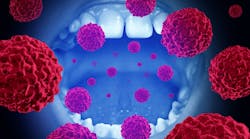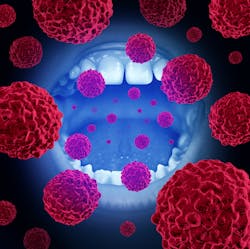HPV-related oral cancer and the importance of screening: A dialogue with the AGD
Some of the most difficult cancer to detect is oral cancer related to the human papillomavirus. Read this informative dialogue between Dr. Stacey Simmons and Academy of General Dentistry Spokesperson Dr. Gerald J. Botko about the dentist's role in HPV detection, types of treatment, how to educate patients about this alarming disease, and the importance of oral cancer screening.
This article first appeared in the newsletter, DE's Breakthrough Clinical with Stacey Simmons, DDS. Subscribe here.
What would you say if someone came up to you and said you saved their life because you were just doing your job? A routine checkup and cleaning resulted in the detection of a small lesion in the external right submandibular area that led to further investigation and subsequent head and neck cancer treatment. The question begs answering, then, what would have happened to this patient had the oral cancer screeningnot been completed?
So, I ask: Do you perform routine oral head and neck cancer screenings on your patients? Some of the most difficult cancers to detect are human papillomavirus-related (HPV) oral cancers, and dentists are often the first line of defense in detection. It is, therefore, prudent for us to be in the know.
The following is a very informative question-and-answer dialogue with Academy of General Dentistry (AGD) Spokesperson Gerald J. Botko, DMD, MS, MAGD, FACD, on the subject of HPV, our role as dentists in its detection, various types of treatment, how we can educate our patients about this disease that is increasing in numbers, and the importance of oral cancer screening for all of our patients.
Why has there been such a dramatic increase in HPV-related oral cancers?
Dr. Gerald Botko: HPV in the mouth and throat is the leading cause of oropharyngeal cancer, a common form of oral cancer. Each year, in the United States, approximately 9,000 people are diagnosed with oropharyngeal cancer who may be associated with HPV-16, the high-risk strain of HPV most responsible for oropharyngeal cancer in adults. Over the past decade, there has been a rapid rise in the detection of these types of cancer—even in nonsmokers and nondrinkers—among patients in their 40s and 50s. It is believed that this higher rate of oropharyngeal cancers is due to an increase in HPV infection.
Statistically, more than 70% of oropharyngeal squamous cell carcinoma is attributed to HPV. More than 50% of sexually active people will have some type of HPV infection at some point in their lives. However, the majority of those infected will clear the virus within two years. The chronic infections can lead to HPV—oropharyngeal squamous cell carcinoma. The risk for HPV-related cancers is six to seven times more common in young men. The increase is also affected by the public's lack of education and underutilization of immunization programs for nine- to 12-year-olds (both males and females).
Why is early detection so important?
Dr. Botko: Oral cancer is particularly dangerous, because it can go unnoticed in its preliminary stages. This is why regularly visiting the dentist is critical for improving the likelihood of early oral cancer detection and survival. In many cases, dentists can detect the disease early, which makes the dental community the first line of defense against oral cancer.
Does the AGD have any programs in place to help general dentists spread the word to patients?
Dr. Botko: The Academy of General Dentistry Foundation—the philanthropic arm of the AGD—is committed to raising awareness of oral cancer and supporting the general dentist as the public’s first line of defense against this deadly disease. The AGD Foundation is creating initiatives to:
- Enhance public awareness of oral cancer through free oral cancer screenings, public service announcements, and patient education tools such as podcasts, webinars, and lectures
- Offer AGD member-dentists free or low-cost continuing education on the latest oral cancer identification techniques
- Provide financial grants to AGD constituents and nonprofit programs that aim to educate the public about oral cancer risk factors and prevention
- Share new knowledge, groundbreaking research, and gain a better understanding of oral cancer through an intellectual partnership with the Global Oral Cancer Forum
What are the new ways to detect oral cancer?
Dr. Botko: During an oral cancer screening, the dentist will feel for lumps or irregular tissue changes in the patient's neck, head, cheeks, and oral cavity. He or she also will examine the soft tissues in the mouth, looking for sores or discolored tissues. The dentist also may use screening devices that use rinses, dyes, or different types of lights to detect abnormal cells. It’s important to assure patients that performing a screening does not necessarily mean you think they have cancer. An oral cancer screening is part of a routine dental checkup, even when the patient has no symptoms. A few companies have developed and use biomarkers found in saliva, which help in the early detection of cancer.
Are we detecting oral cancer earlier than in the past? If so, how?
Dr. Botko: Unfortunately, only about 50% of patients in the United States currently receive an oral screening exam (visual and tactile palpation intraorally and extraorally). It is important to do a thorough oral screening exam on all patients annually, along with taking a comprehensive medical history that details tobacco and alcohol use, age, gender, occupation, lifestyle, etc. Ask about symptoms such as sores that do not heal in the mouth; persistent mouth pain; swelling or lumps in the cheeks, jaw, or neck; and difficulty chewing, swallowing, or speaking.
What are today’s screening recommendations for oral cancer?
Dr. Botko: Thorough intra- and extraoral examinations with a complete medical history define the gold standard. Adjunctive fluorescent technology is available; however, the bottom line is that the value of this technology is questionable. It is often subjective, and a biopsy is always necessary for suspicious lesions. That’s why the new salivary biomarkers hold so much hope. The use of salivary testing should decrease the numbers of unnecessary negative biopsies. There is a need to identify occult lesions as early as possible and reduce the need for aggressive treatment morbidity and mortality.
A final note: Is there anything else dentists and patients should know?
Dr. Botko: Here are some things for both patients and dentists to keep in mind ....
For patients: Patients should know that the common signs of oropharyngeal cancer are: (1) persistent sore throat, (2) earaches, (3) hoarseness, (4) enlarged lymph nodes, (5) pain when swallowing, and (6) unexplained weight loss. Speak with your dentist or physician if you experience several of these symptoms for more than two weeks.
More research is needed to understand how HPV in the mouth and throat can be prevented. The Centers for Disease Control and Prevention recommends that all preteen boys and girls ages nine to 12 be vaccinated for HPV, before they become sexually active. The vaccine is also recommended for males through age 21 and females through age 26, if they did not receive the vaccine as a preteen. For more information on how to lower your risk of HPV, speak with your physician.
As previously stated, regularly visiting the dentist is critical to improve the likelihood of early oral cancer detection and survival. Talk with your dentist for more information about the oral signs of HPV and how you can reduce your risk of developing oropharyngeal cancer.
For dentists:As dentists, we know how devastating oral cancer can be if it is not diagnosed and treated in its early stages. I treat oral cancer patients in my practice. Unfortunately, many patients we treat have cancer in Stages III and IV, which requires radical head and neck dissection, postoperative radiotherapy, and/or chemotherapy. The quality of life of such patients is decreased, as is their chance of survival. This should motivate all of us to want to eradicate this silent killer. Not only do some patients not visit a dentist, but there are still many dentists who do not routinely perform head and neck cancer examinations. It is essential for dentists to take thorough medical histories, as well as educate all patients about oral cancer and oropharyngeal cancer.
Educating our patients about the danger of HPV tactfully with concern for the overall patient shows that, as their provider, you care. The journey of becoming comfortable with educating patients about HPV is to have a plan and a protocol. Encourage your patients to talk to their loved ones and friends about the importance of a thorough oral cancer screening.
This article first appeared in the newsletter, DE's Breakthrough Clinical with Stacey Simmons, DDS. Subscribe here.
For more articles about clinical dentistry, click here.
For the most current dental headlines, click here.
About the Author
Stacey L. Simmons, DDS
Editorial Director of DE's Breakthrough Clinical e-newsletter
Dr. Stacey Simmons grew up in Hamilton, Montana. She did part of her undergraduate work at Purdue University and then received her bachelor’s degree in exercise physiology from the University of Utah. After applying to both medical and dental school, she decided that dentistry was her career of choice. She received her DDS degree from Marquette University School of Dentistry in Milwaukee, Wisconsin, in 2004. In private practice, she focuses her care on prosthodontics and cosmetic dentistry. She is a guest lecturer in the Anatomy and Physiology Department at the University of Montana. Outside the office, she trains for triathlons and spends time with her family. You may contact Dr. Simmons by email at [email protected].
In 2015, Dr. Simmons became the editorial director of DE's Breakthrough Clinical with Stacey Simmons, DDS, an e-newsletter focused on breaking through plateaus in clinical practice. Subscription information may be found here.
Updated May 4, 2016



